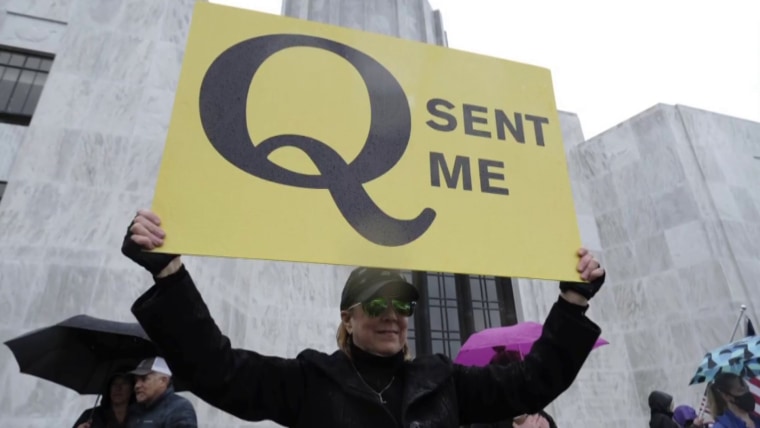QAnon moves from pro-Trump rallies to local schools
Maybe it shouldn’t come as a surprise that QAnon, the once-fringe conspiracy theory with a cult following that buoyed former President Donald Trump’s campaign brand over the past few years — much like the former president himself — has refused to go away.
Local schools are a target for good reason.
Years of rising white supremacist extremism, coupled with pandemic-era growth in QAnon conspiracy theories, anti-establishment ideas and anti-vaccine and anti-science beliefs, have helped channel once-fringe ideas into the mainstream. Increasingly, the mainstream channel of choice is the public school classroom.
The current conservative hysteria around critical race theory has brought local communities and school systems into the thick of it as fringe candidates hope to galvanize conservative resistance into electoral support for more extreme ideas.
This strategy is known as entryism — the use of mainstream political parties and systems to introduce radical and fringe ideas to the public. Entryism was originally an extreme leftist tactic, introduced by communists who worked to infiltrate socialist parties and move them toward communism. Today, it is the far right and conspiracy theorists working to mainstream extreme ideas — by carrying them to the public on elected Republican platforms, through conservative campus groups and by winning local school board seats.
Education has long been a battleground for competing claims about the nation and its history. In generations past, parents on the fringes of mainstream society might have opted to homeschool their children rather than participate in the school system. Today, they are increasingly attempting to influence mainstream education itself.
Over the past few years, college campuses have been targeted with over 1,500 instances of white supremacist propaganda.
The goal is to insert controversial and taboo ideas into the mainstream, exposing new recruits to extremist ideas, gaining power over local decision-making and broadening the movement. Over time, this can help shift the so-called Overton window of acceptable public policy solutions further toward the fringes.
Local schools are a target for good reason. Unlike in many other countries, where curriculum is national, in the United States, local communities have tremendous autonomy in deciding what students learn. Elected school boards approve curriculum, hire and fire district superintendents and negotiate teacher contracts. This means local school boards have tremendous power to influence children’s lives, from determining policies about transgender bathroom usage to deciding how the history of slavery is taught.
K-12 systems are not the only ones that are vulnerable: Universities are also on the front lines of extremist attacks. Just over the past few years, college campuses have been targeted with over 1,500 instances of white supremacist propaganda — fliers, banners, stickers and posters. Extremists and provocateurs have worked to take over conservative student groups and secure speaking invitations that have generated violent counterprotests and backlash. Campuses have endured hundreds of hate crimes and hate incidents, from swastikas stamped in the snow to nooses hung from campus trees and physical assaults on students, staff and visitors.
Schools and colleges are targeted because they hold power to shape how people think. The far right has long seen educational institutions as part of an orchestrated liberal plot to indoctrinate youth with unpatriotic and “unnatural” ideas. Gender-neutral bathrooms or the teaching of critical race theory are framed as a danger to Western civilization itself, threatening to corrode traditional family values, eliminate “God-given” differences between the sexes and produce a generation of kids who will hate themselves and their country.
Schools are not the only target for entryism. In local elections across the country, conspiracy and extremist candidates are successfully running for office, bringing QAnon conspiracy and other fringe ideas into roles as mayors, sheriffs, state legislators and more. But schools and colleges are on the front lines because the extreme right understands the power of education to shape future generations.
We found that it only takes seven minutes of reading for parents to improve their ability to recognize extremist propaganda.
The good news is that education may also be our best way out of this mess. Last month, the Biden administration’s new National Strategy for Countering Domestic Terrorism specifically called out the importance of education, including digital and media literacy and critical thinking skills, as a key to preventing radicalization to violence. There is already good evidence that people can be taught to recognize disinformation and propaganda in ways that can help them resist it the next time they encounter it.
Also encouraging is that communities are hungry for resources. Thousands of parents and teachers have attended my research lab’s webinars about online youth radicalization over the past year. We found that it only takes seven minutes of reading for parents to improve their ability to recognize extremist propaganda and feel empowered to respond more effectively.
But for people to do that in the first place, they must see extremist ideas for what they are: a threat to democracy and the stability of our political system. America’s biggest problem with growing extremism, in the end, appears to be less about the threat from external fringe groups and more about the calls coming from inside the house.
On the heels of raucous parent protests against district gender identity policies, teachers union warnings about conspiracy theorists infiltrating school boards and local battles over the teaching of critical race theory, America’s schools are gearing up for a contentious year ahead.
The battle against extremism is a lot harder to wage when the extreme has already gone mainstream — a lesson school boards, university presidents and other educators across the country are learning all too fast.




